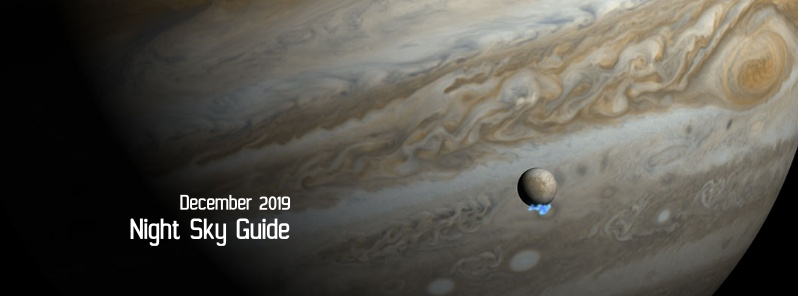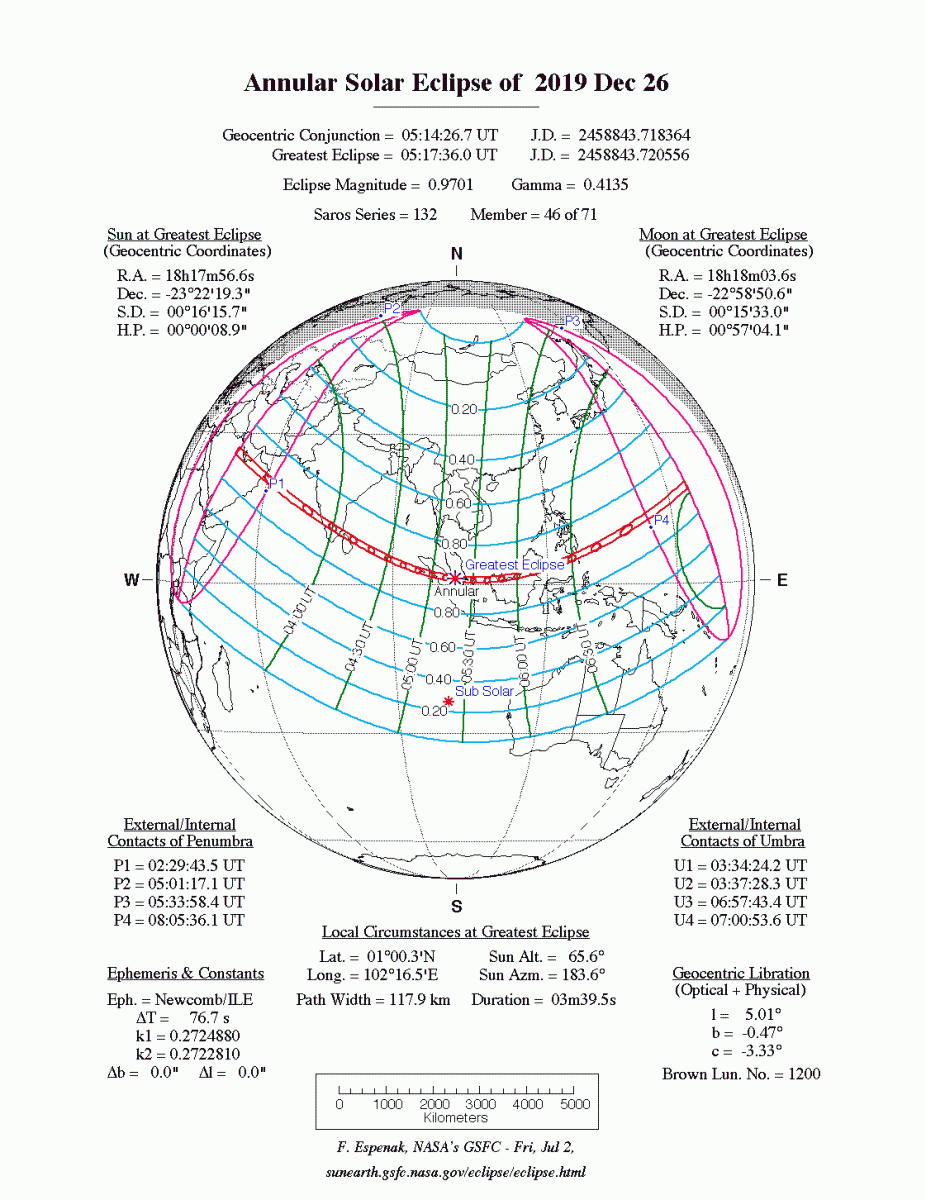Night Sky Guide for December 2019

-
December 2 – Pheonicid meteor shower. The Pheonicid meteor shower is active from November 28 to December 9, producing its peak rate of meteors around December 2. Over this period, there will be a chance of seeing Pheonicid meteors from anywhere where the shower's radiant point – in the constellation Phoenix – is above the horizon.
-
December 6 – December φ-Cassiopeid meteor shower. The December φ-Cassiopeid meteor shower is active from December 1 to 8, producing its peak rate of meteors around December 6. The shower's radiant point is in the constellation Andromeda.
-
December 7 – Puppid-Velid meteor shower. This meteor shower is active from December 1 to 15, peaking around December 7. Its radiant point is in the constellation Vela.
-
December 11 – Conjunction of Venus and Saturn – 04:41 UTC. Venus and Saturn will share the same right ascension, with Venus passing 1°48' to the south of Saturn. At around the same time, the two objects will also make a close approach, technically called an appulse. Venus will be at mag -4.0, and Saturn at mag 0.5, both in the constellation Sagittarius. The pair will be too widely separated to fit within the field of view of a telescope but will be visible to the naked eye or through a pair of binoculars.
-
December 12 – Full Moon – 05:12. This full moon was known by early Native American tribes as the Full Cold Moon because this is the time of year when the cold winter air settles in and the nights become long and dark. This moon has also been known as the Full Long Nights Moon and the Moon Before Yule.
-
December 12 – σ-Hydrid meteor shower. The σ-Hydrid meteor shower is active from December 3 to 15, producing its peak rate of meteors around December 12. The radiant point is in the constellation Hydra.
-
December 12 – LMC is well placed. Across much of the world the Milky Way's dwarf companion, the Large Magellanic Cloud (LMC), in Dorado will be well placed for observation. It will reach its highest point in the sky at around midnight local time. At a declination of -69°45', it is easiest to see from the southern hemisphere but cannot be seen from latitudes much north of 0°N. At magnitude 0.9, LMC is visible to the naked eye, but best viewed through a pair of binoculars.
-
December 13 – Conjunction of Venus and Pluto – 16:58 UTC. Venus and Pluto will share the same right ascension, with Venus passing 1°08' to the south of Pluto. Venus will be at mag -4.0, and Pluto at mag 15.1, both in the constellation Sagittarius. The pair will be too widely separated to fit within the field of view of a telescope but will be visible through a pair of binoculars.
-
December 13, 14 – Geminid meteor shower. Considered by many to be the best shower in the heavens, Geminids can be observed each year from December 7 to 17. At its peak, the shower can produce up to 120 multicolored meteors per hour. Unfortunately, the nearly full moon will block out many of the meteors this year, but the Geminids are so bright and numerous that it could still be a good show. The best viewing will be from a dark location after midnight. Meteors will radiate from the constellation Gemini but can appear anywhere in the sky. The shower is produced by debris left behind by an asteroid known as 3200 Phaethon, which was discovered in 1982.
-
December 15 – Close approach of the Moon and M44 – 16:52 UTC. The Moon and M44 will make a close approach, passing within 1°17' of each other. The Moon will be at mag -12.6, and M44 at mag 3.1, both in the constellation Cancer. The pair will be too widely separated to fit within the field of view of a telescope but will be visible through a pair of binoculars.
-
December 15 – NGC 1981 well placed for observation. The open star cluster NGC 1981 in Orion's sword will be well placed for observation. It will reach its highest point in the sky at around midnight local time. At a declination of -04°25', it is visible across much of the world; it can be seen at latitudes between 65°N and 74°S. At magnitude 4.2, NGC1981 is tricky to make out with the naked eye except from a dark site but is visible through a pair of binoculars or a small telescope.
-
December 16 – Comae Berenicid meteor shower. The Comae Berenicid meteor shower is active from December 12 to 23, producing its peak rate of meteors around December 16. At its peak, the shower is expected to produce a nominal rate of around 3 meteors per hour.
-
December 20 – December Leonis Minorid meteor shower. The December Leonis Minorid meteor shower is active from December 5 to February 4, producing its peak rate of meteors around December 20. The shower's radiant point is in the constellation Leo Minor.
-
December 22 – December Solstice – 04:04 UTC. The South Pole of the Earth will be tilted toward the Sun, which will have reached its southernmost position in the sky and will be directly over the Tropic of Capricorn at 23.44 degrees south latitude. This is the first day of winter (winter solstice) in the northern hemisphere and the first day of summer (summer solstice) in the southern hemisphere.
-
December 23 – Ursid Meteor Shower. The Ursid meteor shower is active from December 17 to 26, producing its peak rate of meteors around December 23. The shower's radiant point is in the constellation Ursa Minor. The Ursids is a minor meteor shower producing about 5-10 meteors per hour. The waning crescent moon should not interfere too much this year. Skies should still be dark enough for what could be a good show. Best viewing will be just after midnight from a dark location far away from city lights. Meteors will radiate from the constellation Ursa Minor, but can appear anywhere in the sky. Ursids are produced by dust grains left behind by comet Tuttle, which was first discovered in 1790.
-
December 23 – Close approach of the Moon and Mars. The Moon and Mars will make a close approach, passing within 3°20' of each other. The Moon will be at mag -10.3, and Mars at mag 1.6, both in the constellation Libra. The pair will be too widely separated to fit within the field of view of a telescope but will be visible to the naked eye or through a pair of binoculars. At around the same time, the two objects will also share the same right ascension – called a conjunction.
-
December 26 – New Moon – 05:13 UTC. The Moon will pass close to the Sun and become lost in the Sun's glare for a few days. This is the best time of the month to observe faint objects such as galaxies and star clusters because there is no moonlight to interfere. The Moon's orbital motion carries it around the Earth once every four weeks, and as a result its phases cycle from new moon, through first quarter, full moon and last quarter, back to new moon once every 29.5 days. This motion also means that the Moon travels more than 12° across the sky from one night to the next, causing it to rise and set nearly an hour later each day. At new moon, the Earth, Moon and Sun all lie in a roughly straight line, with the Moon in the middle, appearing in front of the Sun's glare. In this configuration, we see almost exactly the opposite half of the Moon to that which is illuminated by the Sun, making it doubly unobservable because the side we see is unilluminated.
-
December 26 – Annular Solar Eclipse – from 02:31 to 08:05 UTC. An annular solar eclipse occurs when the Moon is too far away from the Earth to completely cover the Sun, resulting in a ring of light around the darkened Moon. The path of of the eclipse will begin in Saudi Arabia and move east through southern India, northern Sri Lanka, parts of the Indian Ocean, and Indonesia before ending in the Pacific Ocean. A partial eclipse will be visible throughout most of Asia and northern Australia. The Sun's corona is not visible during an annular eclipse.

- December 27 – Conjunction of the Moon and Saturn – 11:48 UTC. The Moon and Saturn will share the same right ascension, with the Moon passing 1°12' to the south of Saturn. The Moon will be at mag -8.3, and Saturn at mag 0.5, both in the constellation Sagittarius. The pair will be too widely separated to fit within the field of view of a telescope but will be visible to the naked eye or through a pair of binoculars.
-
December 27 – Jupiter at solar conjunction – 18:29 UTC. Jupiter will pass very close to the Sun in the sky as its orbit carries it around the far side of the solar system from the Earth. At the closest approach, Jupiter will appear at a separation of only 0°05' from the Sun, making it totally unobservable for several weeks while it is lost in the Sun's glare. At around the same time, Jupiter will also be at its most distant from the Earth – receding to a distance of 6.21 AU – since the two planets will lie on opposite sides of the solar system.
-
December 29 – Conjunction of the Moon and Venus – 01:32 UTC. The Moon and Venus will share the same right ascension, with the Moon passing 0°59' to the south of Venus. At around the same time, the two objects will also make a close approach, technically called an appulse. The Moon will be at mag -9.9, and Venus at mag -4.0, both in the constellation Capricornus. The pair will be a little too widely separated to fit comfortably within the field of view of a telescope, but will be visible to the naked eye or through a pair of binoculars.
-
December 29 – NGC 2232 well placed for observation. The open star cluster NGC 2232 in Monoceros will be well placed for observation. It will reach its highest point in the sky at around midnight local time. At a declination of -04°50', it is visible across much of the world; it can be seen at latitudes between 65°N and 74°S. At magnitude 4.2, NGC2232 is tricky to make out with the naked eye except from a dark site, but is visible through a pair of binoculars or a small telescope.
-
December 30 – NGC 2244 well placed for observation. The open star cluster NGC 2244, in the rosette nebula in Monoceros will be well placed for observation. It will reach its highest point in the sky at around midnight local time. At a declination of +04°56', it is visible across much of the world; it can be seen at latitudes between 74°N and 65°S. At magnitude 4.8, NGC2244 is too faint to be seen with the naked eye from any but the very darkest sites but is visible through a pair of binoculars or a small telescope.

Video courtesy Hubble Space Telescope
Sources: In The Sky by Dominic Ford, NASA
Featured image: NASA, ESA, and M. Kornmesser

Commenting rules and guidelines
We value the thoughts and opinions of our readers and welcome healthy discussions on our website. In order to maintain a respectful and positive community, we ask that all commenters follow these rules.